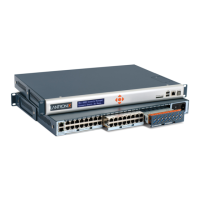8: Device Ports
SLC™ 8000 Advanced Console Manager User Guide 182
CBCP Server
The SLC 8000 advanced console manager waits for a client to call the SLC unit, establishes a
PPP connection, authenticates the user, and negotiates a dial-back number with the client using
CBCP. If the SLC 8000 advanced console manager is able to determine a dial-back number to
use, it hangs up and calls the dial-back number.
When a call is received, a PPP connection is established, and the user will be authenticated via
PAP or CHAP (configured with the Authentication setting). For PAP, the Local/Remote list will be
used to authenticate the login and password sent by the PPP peer. For CHAP, the CHAP
Handshake Host/User Name and Secret/User Password will be used to authenticate CHAP
Challenge response sent by the PPP peer. If the remote peer requests PAP or CHAP
authentication from the SLC unit, the Remote/Dial-out Login and Remote/Dial-out Password
will be provided as authentication tokens. Once authenticated, the CBCP handshake with the
client determines the number to use for dial-back. The SLC unit will present the client with the
available options: if the authenticated user is a Local/Remote User with Allow Dial-back enabled
and a Dial-back Number defined, the administrator-defined option is allowed; if this is not the case,
the user-defined number is allowed. Additionally, if CBCP Server Allow No Callback is enabled,
the client can also select no callback (the PPP connection established at dial-in will remain up).
The client will select from the available callback options. If the SLC unit can determine a dial-back
number to use, it will hang up and wait Dial-back Delay seconds before initiating the dial-back (if
the dial-back fails, the SLC will try Dial-back Retries times to dial-back). The SLC unit will call
back the previously authenticated remote peer, and if the remote peer requests PAP or CHAP
authentication, provide the Remote/Dial-out Login and Remote/Dial-out Password as
authentication tokens. Once authenticated, a PPP session will be established using either
negotiated IP addresses or specific IP addresses (determined by the Negotiate IP Address
setting).
CBCP Client
The SLC unit will dial out to a CBCP server, establish a PPP connection, negotiate a callback
number with the server using CBCP, terminate the connection, and wait for the server to call back.
The SLC unit dials the Dial-out Number, and if the remote peer requests PAP or CHAP
authentication, provides the Remote/Dial-out Login and Remote/Dial-out Password as
authentication tokens. Once authenticated, the CBCP handshake with the server determines the
number to use for dial-back. The SLC device will request the type of number defined by CBCP
Client Type - either an Admin-defined Number (the CBCP server determines the number to call)
or a User-defined Number (the SLC unit will provide the Fixed Dial-back Number as the number
to call). If the CBCP handshake is successful, the SLC unit will terminate the PPP connection,
hang up, and wait for the server to dial back. When the remote server calls back the SLC unit and
the PPP connection is established, the user will be authenticated via PAP or CHAP (configured
with the Authentication setting). For PAP, the Local/Remote list will be used to authenticate the
login and password sent by the PPP peer. For CHAP, the CHAP Handshake Host/User Name
and Secret/User Password will be used to authenticate CHAP Challenge response sent by the
PPP peer. Once authenticated, a PPP session will be established using either negotiated IP
addresses or specific IP addresses (determined by the Negotiate IP Address setting).
Notes:
In a state where the modem will be answering a call, the modem should always be
configured for manual answer, not auto answer.
When answering a call, the SLC unit answers after the 2nd ring.
Any text or PPP connection can be terminated by setting the modem state to disabled.

